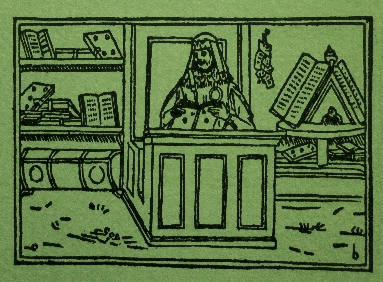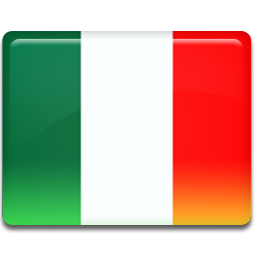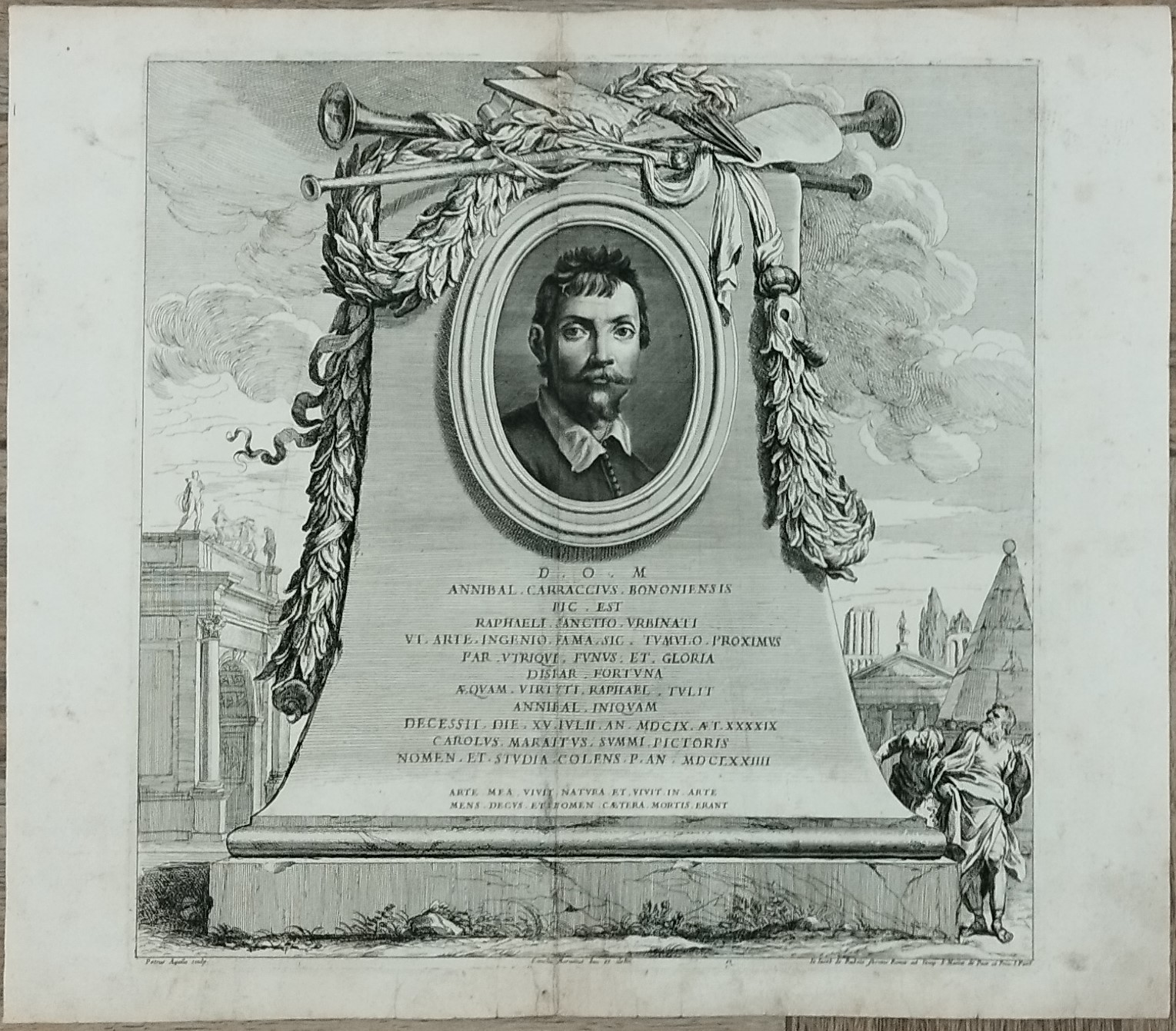Acquaforte e bulino, di mm 413 x 415. Filigrana presente ma non identificata.Didascalia: Monumento funebre fittizio di Annibale Carracci; Monumento funebre fittizio di Annibale Carracci; in un plinto, il ritratto di Annibale Carracci, testa e spalle, rivolto in avanti, in un ovale, visto al centro, iscrizione latina sotto l’ovale; a coronamento del plinto, foglie di alloro, due trombe, una tavolozza e un piccolo dipinto; dietro il basamento, monumenti e antichità e due figure viste a destra, meravigliate del monumento. Dentro all’inciso l’iscrizione: D.O.M./ ANNIBAL CARRACCIUS BONONIENSIS/HIC EST/ RAPHAELI SANCTIO URBINATI/ UT ARTE INGENIO FAMA SIC TUMULO PROXIUMUS/ PAR UTRIQUE FUNUS ET GLORIA/AQUAM VIRTUTI RAPHAEL TULIT/ANNIBAL INIQUAM/DECESSIT DIE XV IULII AN MDCCIX AT XXXXIX/CAROLUS MARATTUS SUMMI PICTORIS/NOMEN ET STUDIA COLENS P. AN MDCLXXIIII. Dentro la battuta, in piccolo, in basso a sinistra: Petrus Aquila sculp. Al centro: Carlus Maratus inv et delin. A destra: Io Iacobus de Rubeis formis Romae ad Templ. S. Mariae de Pace cu. priv. S. Pont. Pietro Aquila (italiano, Marsala, Sicilia 1650–1692/1700 Roma): è stato un pittore e incisore italiano del periodo barocco.Carlo Maratta, talvolta menzionato anche come Carlo Maratti (Camerano, 15 maggio 1625 – Roma, 15 dicembre 1713), è stato un pittore e restauratore italiano. Pietro Aquila ha inciso una serie di 21 tavole numerate riproducenti la galleria di Palazzo Farnese e precedute da quattro tavole non numerate costituite da: frontespizio, dedica, allegoria con Annibale Carracci che risolleva le sorti della pittura e monumento funebre ad Annibale Carracci. Il foglio qui catalogato è un esemplare di quest’ultima incisione. La serie è stata stampata da Giovanni Giacomo De Rossi ed è accompagnata da versi di Giovanni Pietro Bellori; essa compare nel catalogo di vendita della bottega De Rossi del 1677 come opera stampata in quell’anno, anche se la stampa con il monumento al Carracci è datata 1674. I rami della serie, conservati presso la Calcografia Camerale, furono fatti distruggere nel 1824 da papa Leone XII per le iconografie considerate troppo audaci.
Etching and burin, 413 x 415 mm. Watermark present but not identified. Caption: Fictitious funerary monument of Annibale Carracci; Fictitious funeral monument of Annibale Carracci; in a plinth, the portrait of Annibale Carracci, head and shoulders, facing forward, in an oval, seen in the center, Latin inscription under the oval; crowning the plinth, laurel leaves, two trumpets, a palette and a small painting; behind the base, monuments and antiquities and two figures seen on the right, amazed by the monument. Inside the engraving the inscription: D.O.M./ ANNIBAL CARRACCIUS BONONIENSIS/HIC EST/ RAPHAELI SANCTIO URBINATI/ UT ARTE INGENIO FAMA SIC TUMULO PROXIUMUS/ PAR UTRIQUE FUNUS ET GLORIA/AQUAM VIRTUTI RAPHAEL TULIT/ANNIBAL INIQUAM/DECESSIT DIE XV IULII AN MDCCIX AT XXXXIX/CAROLUS MARATTUS SUMMI PICTORIS/NOMEN ET STUDIA COLENS P. AN MDCLXXIIII. Inside the joke, in small, bottom left: Petrus Aquila sculp. Center: Carlus Maratus inv et delin. On the right: I Iacobus de Rubeis formis Romae ad Templ. S. Mariae de Pace cu. private S. Pont. Pietro Aquila (Italian, Marsala, Sicily 1650–1692/1700 Rome): was an Italian painter and printmaker of the Baroque period. Carlo Maratta, sometimes also mentioned as Carlo Maratti (Camerano, 15 May 1625 – Rome, 15 December 1713), was an Italian painter and restorer. Pietro Aquila engraved a series of 21 numbered plates reproducing the gallery of Palazzo Farnese and preceded by four unnumbered plates consisting of: frontispiece, dedication, allegory with Annibale Carracci who revives the fortunes of painting and funerary monument to Annibale Carracci. The sheet cataloged here is an example of this last engraving. The series was printed by Giovanni Giacomo De Rossi and is accompanied by verses by Giovanni Pietro Bellori; it appears in the sales catalog of the De Rossi workshop of 1677 as a work printed in that year, even if the print with the monument to Carracci is dated 1674. The branches of the series, preserved in the Chalcografia Camerale, were destroyed in 1824 by Pope Leo XII for the iconography considered too bold.


